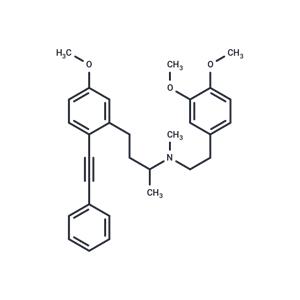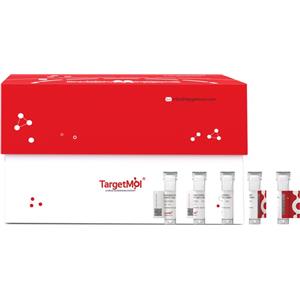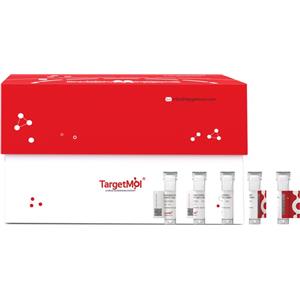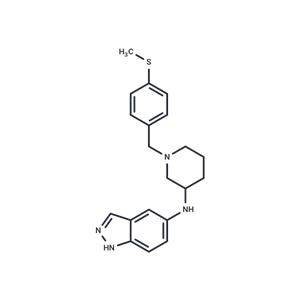Product Details
| Product Name:
McN5691 |
CAS No.:
99254-95-2 |
| Purity:
99.24% |
Supply Ability:
10g |
| Release date:
2024/11/20 |
Product Introduction
Bioactivity
| Name | McN5691 |
| Description | McN5691 (RWJ26240) is a voltage-dependent calcium channel blocker with antihypertensive activity that can be used in the study of diseases caused by vascular smooth muscle abnormalities. |
| In vitro | McN5691 has a complete high-affinity inhibition (Kd=39.5 nM) of specific diltiazem binding to benzothiazepine receptors on voltage-sensitive calcium channels in skeletal muscle microsomal membranes. In contrast to diltiazem, McN5691 inhibited specific dihydropyridine receptor binding, but this effect was biphasic, with both high-affinity (Kd=4.7 nM) and low-affinity (Kd=919.8 nM) components.McN5691 inhibited norepinephrine (NE)-induced constriction (10 μM) and calcium uptake (1 and 10 μM), and caused 1 μM NE contraction of rabbit thoracic aortic rings to produce concentration-dependent relaxation (EC50=159 μM) [1]. McN5691 (1 and 10 μM) prevented 60 mM KCl-induced contraction and calcium uptake and produced concentration-dependent relaxation (EC50=190 μM) in aortic rings contracted with 30 mM KCl. At concentrations of 10 μM or less, McN5691 (McN-5691) had no effect on basal tension or calcium uptake (45Ca) in isolated rings of rabbit thoracic aorta. |
| In vivo | McN5691 is extensively metabolized in dogs. In 0-24 hour urine and 0-48 hour fecal extracts, the levels of unchanged McN5691 were less than 0.1% and 19% of the dose, respectively, while in 4-hour plasma, the level of unchanged McN5691 was 36% of the sample [2]. In the McN5691 (McN-5691) study, vascular resistance tended to be higher in spontaneously hypertensive rats (SHR) than in Wistar-Kyoto (WKY), but the difference was only statistically significant in the cerebellum and midbrain [3]. Researchers investigated the excretion and metabolism of the 2-ethynylphenylalkylamine analog, the antihypertensive drug McN5691 (RWJ-26240), in beagles. Within 7 days of oral administration of 14C-McN5691, 96.8% and 2.8% of the radioactive dose was excreted in the feces and urine, respectively. After 7 days of oral administration of 14C-McN5691, 96.8% and 2.8% of the dose was recovered in the feces and urine, respectively. More than 87% of the dose was excreted in the feces within 48 hours.[1] |
| Storage | Powder: -20°C for 3 years | In solvent: -80°C for 1 year | Shipping with blue ice. |
| Keywords | McN5691 | RWJ 26240 | McN-5691 | RWJ-26240 |
| Inhibitors Related | Nisoldipine | Nimodipine | 2,5-Di-tert-butylhydroquinone | Diltiazem hydrochloride | Levetiracetam | L-Ascorbic acid | Lanthanum(III) chloride heptahydrate | Ethyl cinnamate | 1-Octanol | Otilonium bromide |
| Related Compound Libraries | Pain-Related Compound Library | Bioactive Compound Library | Bioactive Compounds Library Max | Ion Channel Targeted Library |
Company Profile Introduction
Target Molecule Corp. (TargetMol) is a global high-tech enterprise, headquartered in Boston, MA, specializing in chemical and biological research product and service to meet the research needs of global customers.
TargetMol has evolved into one of the biggest global compound library and small molecule suppliers and a customer based on 40+ countries. TargetMol offers over 80 types of compound libraries and a wide range of high-quality research chemicals including inhibitors, activator, natural compounds, peptides, inhibitory antibodies, and novel life-science kits, for laboratory and scientific use. Besides, virtual screening service is also available for customers who would like to conduct the computer-aided drug discovery.
You may like
-
-
-
CAS:1035094-83-7
$68.00 / 1mg
Recommended supplier
| Product name |
Price |
|
Suppliers |
Update time |
|
|
$293.00/1mg |
VIP5Y
|
TargetMol Chemicals Inc.
|
2024-11-20 |








 United States
United States